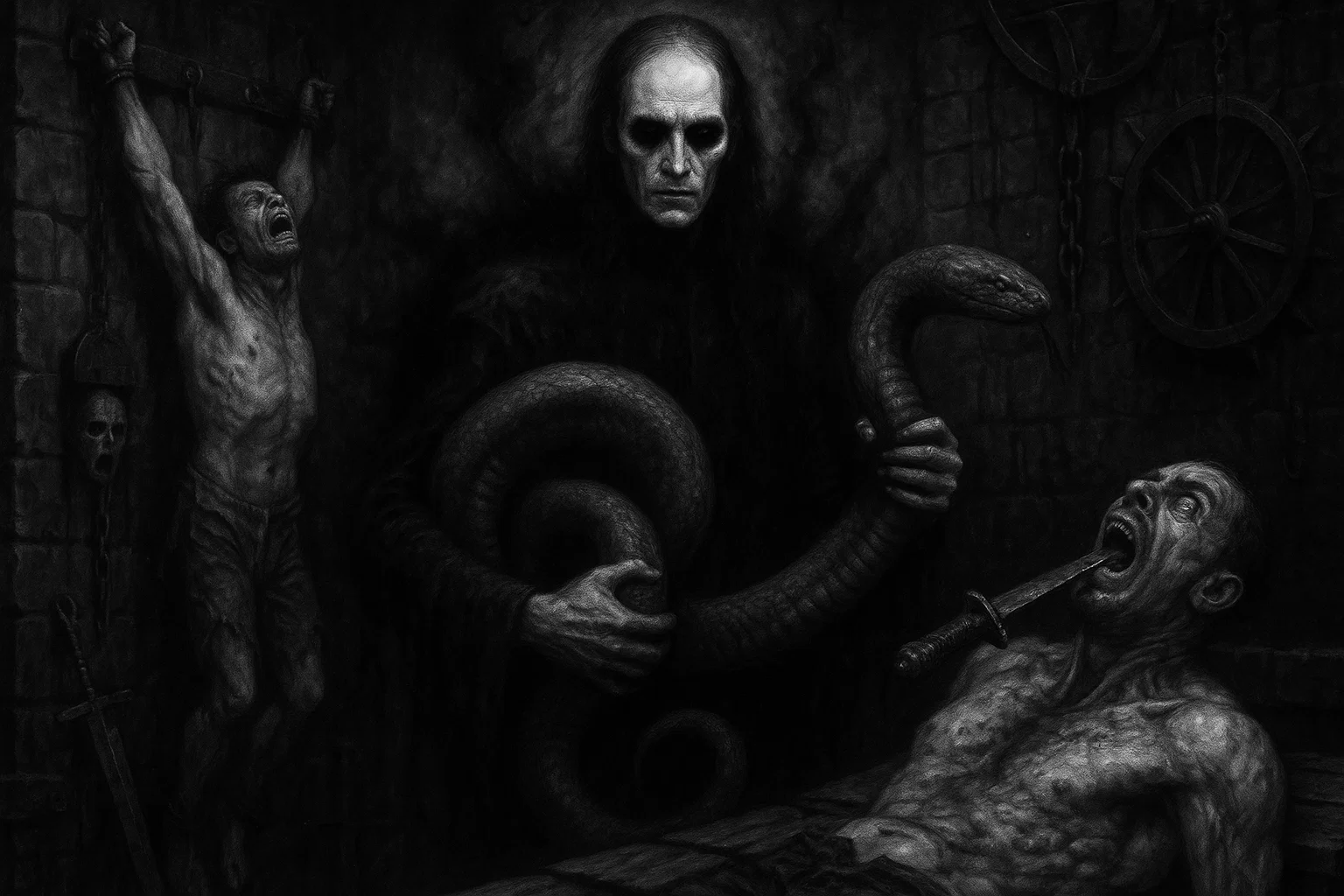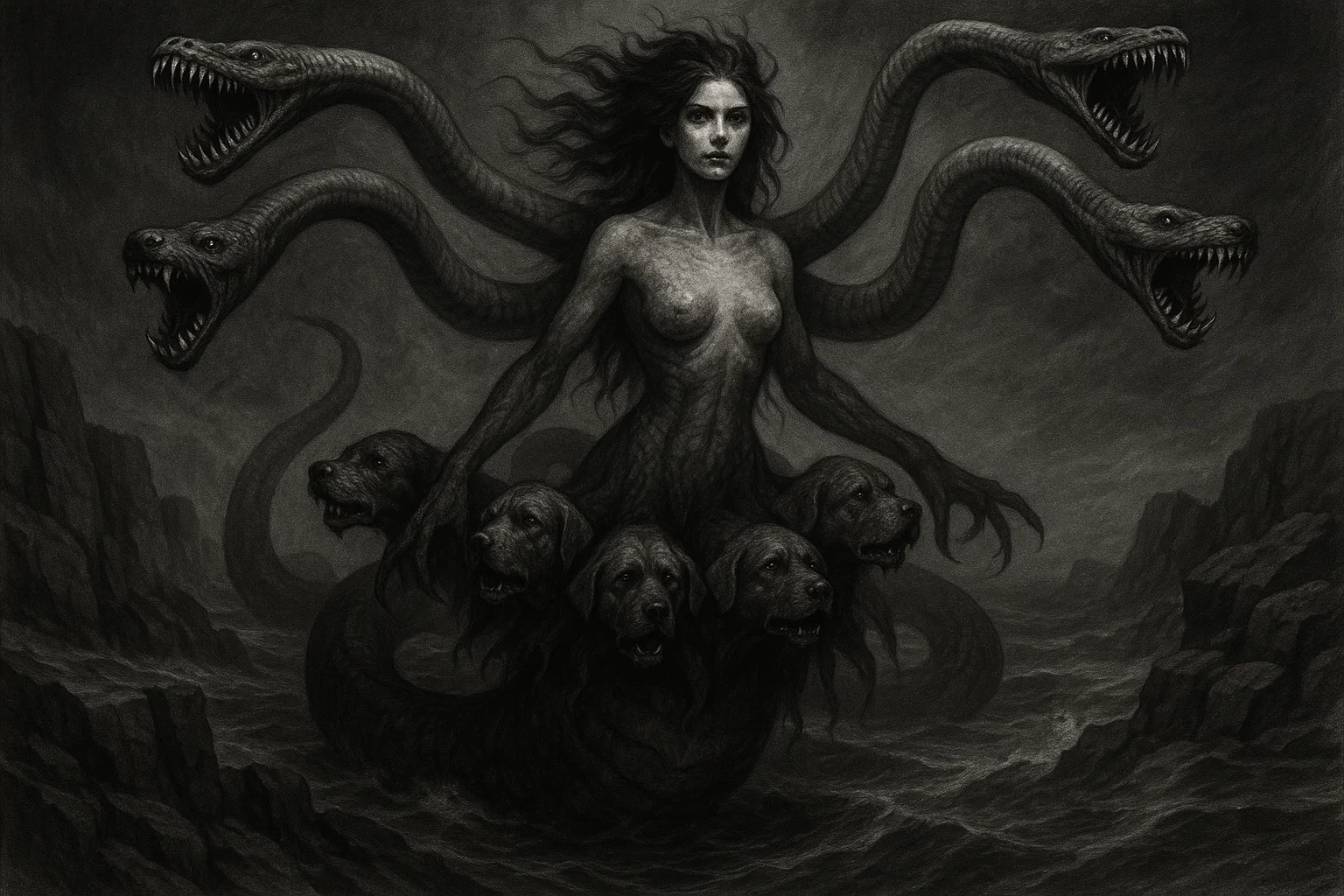Embark on a journey into the arcane world of Andromalius, the 72nd spirit of the Ars Goetia, a revered Great Earl of Hell commanding 36 legions of infernal spirits.
Known for his unyielding pursuit of justice, Andromalius punishes thieves, recovers stolen goods, uncovers hidden treasures, and exposes deceit and wickedness.
Depicted as a man wielding a great serpent, he embodies vigilance and retribution in Goetic demonology. From his roots in Renaissance grimoires to his niche presence in modern occult practices, Andromalius captivates scholars and practitioners alike.
Summary
Key Information
Andromalius is a pivotal figure in Western occult traditions, celebrated for his judicial and revelatory powers. Below is a comprehensive overview of his attributes:
| Attribute | Details |
|---|---|
| Name | Andromalius |
| Alternate Names | None commonly noted |
| Titles | Great Earl of Hell |
| Rank | Earl |
| Appearance | Man holding a great serpent |
| Powers | Punishes thieves, returns stolen goods, uncovers hidden treasures, reveals deceit and wickedness, discovers underhand dealings |
| Number of Legions | 36 |
| Pantheon | Goetic Demonology |
| Primary Sources | Ars Goetia (17th century), Lesser Key of Solomon (1904 ed.) |
| Associated Symbols | Serpent, scales of justice, hidden treasures |
| Associated Gem | Onyx (protection), Hematite (grounding) |
| Associated Color | Black (authority), Green (justice) |
| Astrological Sign | Pisces (March 10–14) |
| Element | Earth |
| Planet | Saturn |
| Opposing Angel | Mumiah |
| Seal | Geometric design used in summoning rituals |
| Modern Depictions | Occult literature, niche video games, esoteric texts |
| Superior Demon | Likely Lucifer or Belial |
| Region of Hell | Not specified, possibly western Hell |
Etymology
What is the origin of Andromalius’s name? The etymology of Andromalius remains a subject of speculation, intriguing demonologists and occult scholars.
The name likely stems from Greek roots, with “andro” meaning “man” or “human,” suggesting a connection to human affairs or moral judgment. The suffix “-malius” may derive from the Latin malus (evil or bad), implying a role in confronting malevolence, such as thievery or deceit. This aligns with his office of punishing wrongdoers and uncovering hidden truths.
Is Andromalius linked to ancient gods?
Some propose a tenuous link to Hermes, the Greek god of thieves and commerce, whose caduceus—a staff entwined with serpents—mirrors Andromalius’s serpent imagery.
You May Also Like: El Silbón: Why Locals Say Its Whistle Means Death Is Near
However, Hermes’s trickster nature contrasts with Andromalius’s punitive role, making this connection unlikely.
Could Andromalius’s name have Roman influences?
The suffix “-ius” is common in Roman names like Julius, suggesting the name was crafted to evoke authority, possibly within the grimoire tradition.
Why is Andromalius’s name unique?
Unlike demons like Astaroth (derived from Astarte), Andromalius lacks clear ties to pre-Christian deities, indicating a Renaissance-era creation to embody justice and vigilance.
Are there Hebrew origins for Andromalius?
A speculative theory points to Hebrew mal’ak (messenger or angel), reflecting his role as an enforcer, but evidence is scarce. The name’s phonetic strength and moral connotations make it a fitting title for a demon of retribution.
Historical and Mythological Background
Andromalius is a product of Western demonology, rooted in the Goetic tradition that catalogs 72 demons allegedly bound by King Solomon. His primary documentation appears in the Ars Goetia, a 17th-century grimoire within the Lesser Key of Solomon, later edited by S.L. MacGregor Mathers and Aleister Crowley in 1904.
As the 72nd spirit, Andromalius is a Great Earl, a rank denoting martial and judicial authority in Hell’s feudal hierarchy. His powers to punish thieves, recover stolen goods, and reveal wickedness reflect Renaissance concerns about property rights and moral corruption during a time of economic upheaval and legal reform.
Unlike demons with ancient origins, such as Bael (linked to Baal) or Amon (Amun-Ra), Andromalius has no clear mythological precursor, suggesting he was crafted for the Goetic canon to address specific societal needs.
Some occultists speculate he was a fallen angel, possibly from the order of Virtues, tasked with divine justice before his rebellion alongside Lucifer. His serpent imagery, a symbol of wisdom and retribution in Christian iconography, supports this narrative, evoking the biblical serpent of Eden or protective serpents in ancient mythologies.
The Renaissance context, marked by mercantilism and rising crime, shaped Andromalius’s portrayal. His abilities would have appealed to merchants and magistrates seeking supernatural aid against theft and deceit.
The Ars Goetia’s compilation, drawing from earlier texts like the Liber Officiorum Spirituum, reflects a synthesis of medieval occultism and emerging scientific thought, positioning Andromalius as a patron of order and clarity in a turbulent era.
His absence from Johann Weyer’s Pseudomonarchia Daemonum (1577), which lists 69 demons, indicates he was a later addition, possibly introduced to address evolving cultural anxieties.
Historical Mentions
Andromalius’s documented appearances are limited, primarily confined to the Ars Goetia. Below is a comprehensive table of his mentions:
| Text | Date | Description |
|---|---|---|
| Ars Goetia | 17th century | 72nd spirit, a Great Earl appearing as a man with a great serpent, punishes thieves, returns stolen goods, uncovers treasures, reveals deceit and wickedness, commands 36 legions. |
| Lesser Key of Solomon | 1904 | Reaffirms Ars Goetia description, edited by Mathers and Crowley, emphasizing his judicial role. |
Ars Goetia:
“The Seventy-second Spirit in Order is named Andromalius. He is an Earl, Great and Mighty, appearing in the Form of a Man holding a Great Serpent in his Hand. His Office is to bring back both a Thief, and the Goods which be stolen; and to discover all Wickedness, and Underhand Dealing; and to punish all Thieves and other Wicked People and also to discover Treasures that be Hid. He ruleth over 36 Legions of Spirits.”
Lesser Key of Solomon (1904 ed.):
“Andromalius, a Great Earl, appeareth in the form of a Man, holding a great Serpent in his hand… He punisheth all Thieves and other Wicked People, and discovereth Treasures that be hidden, and all Evilness and Underhand Dealing.”
Andromalius’s absence from earlier texts like Pseudomonarchia Daemonum or Collin de Plancy’s Dictionnaire Infernal underscores his unique position in the Goetic tradition, likely as a 17th-century addition to address specific societal concerns.
What Andromalius Looks Like
Andromalius is vividly described as a man holding a great serpent, an image rich in symbolism that reflects his domains of justice, protection, and revelation.
The man represents wisdom, authority, and clarity, portraying Andromalius as a rational and calculated figure who restores balance to chaotic situations. His human form suggests accessibility, making him a relatable ally for summoners seeking retribution.
You May Also Like: Kali Oka and Oak Grove Plantations Haunting: Ghost Stories from Saraland, Alabama
The serpent, a potent symbol in Christian and occult traditions, embodies knowledge, transformation, and vigilance. It evokes the biblical serpent of Eden, associated with hidden wisdom, or protective serpents in ancient mythologies, acting as guardians against threats.
The serpent’s “great” size emphasizes Andromalius’s commanding presence, suggesting a coiled, menacing creature ready to strike at malevolence. Holding the serpent signifies mastery over these powers, indicating his ability to wield retribution and uncover deceit with precision.
In occult art, Andromalius is often depicted as a stern, cloaked figure, with the serpent coiled around his arm or at his feet, enhancing his aura of authority and protection. This imagery distinguishes him from animalistic demons like Andrealphus (peacock), emphasizing his role as a judicial enforcer.
Powers and Abilities
Andromalius wields a formidable array of powers centered on justice, revelation, and retribution:
- Punishing Thieves: He delivers infernal retribution to thieves, addressing a pressing concern in Renaissance Europe, where banditry was rampant.
- Returning Stolen Goods: Andromalius locates and restores stolen property, offering restitution to victims of theft, a power that resonates in both historical and modern contexts.
- Uncovering Hidden Treasures: He reveals hidden treasures, interpreted as material wealth or metaphorical insights, appealing to summoners seeking prosperity or knowledge.
- Revealing Deceit and Wickedness: Andromalius exposes lies, underhand dealings, and moral corruption, acting as a celestial detective for those suspecting betrayal or manipulation.
- Commanding Legions: Governing 36 legions of spirits, he wields significant influence, enabling complex tasks across mortal and infernal realms.
In modern occult practices, Andromalius is invoked for protection against negative entities, to secure one’s energy field, and to ward off ill intentions. Practitioners may use his lamen (a pendant bearing his sigil) for safeguarding in dangerous places or to maintain clarity in challenging situations.
Role in the Hierarchy of Hell
As a Great Earl in the infernal hierarchy, Andromalius holds a significant rank below Kings (Bael), Princes (Vassago), and Dukes (Agares) but above Presidents (Marbas) and Knights (Furcas).
The title of Earl, derived from medieval feudal systems, denotes martial and judicial responsibilities, aligning with Andromalius’s role in enforcing order and punishing transgressions.
You May Also Like: The Cursed Noh Mask | Horror Story
Commanding 36 legions—each comprising thousands of spirits—Andromalius wields considerable authority, likely serving under supreme rulers like Lucifer or Belial. His duties focus on maintaining infernal justice, overseeing the punishment of thieves and the revelation of hidden enemies.
His serpent symbolism, tied to vigilance and retribution, distinguishes him from scholarly demons like Alloces or regal ones like Paimon. Some sources speculate he operates in western Hell, alongside directional demons like Amaimon, though this is not confirmed.
Astrological Associations and Symbolism
While the Ars Goetia does not provide astrological correspondences, modern occultists have assigned Andromalius various associations based on his powers and symbolism:
| Correspondence | Associated Item | Meaning |
|---|---|---|
| Planet | Saturn | Discipline, justice, authority |
| Element | Earth | Stability, grounding, material concerns |
| Zodiac Sign | Pisces (March 10–14) | Intuition, mysticism, hidden truths |
| Day of Week | Saturday | Ruled by Saturn |
| Colors | Black (authority), Green (justice) | Power, moral balance |
| Gems | Onyx (protection), Hematite (grounding) | Defense, stability |
| Metals | Lead (Saturn’s metal) | Endurance, transformation |
| Herbs | Comfrey (healing), Patchouli (protection) | Restoration, safeguarding |
| Incense | Myrrh (purification), Frankincense (authority) | Spiritual cleansing, power |
| Animals | Serpent (vigilance), Owl (wisdom) | Retribution, insight |
| Time of Power | Night, Saturday, Pisces season, New Moon | Aligns with Saturnine and judicial energies |
Andromalius is linked to the period March 10–14, under the influence of the Kabbalistic angel Mumiah, the 72nd angel in the Shemhamphorasch, who may act as his celestial counterbalance.
Some modern sources suggest he signifies despair and suicide astrologically, though this interpretation is debated and not universally accepted.
His association with Pisces reflects his intuitive ability to uncover hidden truths, while Saturn and Earth emphasize his role in discipline and material justice.
Sigil
The sigil of Andromalius, as depicted in the Ars Goetia, is a complex geometric design featuring intersecting lines and curves, serving as his infernal signature. Used in summoning rituals, the sigil is drawn in black or green ink to align with his authority and justice.
Practitioners place it on altars, engrave it on talismans, or wear it as a lamen to establish a connection with Andromalius. Precision in drawing the sigil is crucial to ensure ritual efficacy, reflecting his demand for respect and clarity.
Media and Pop Culture
Andromalius has a limited but intriguing presence in modern media, reflecting his niche appeal compared to demons like Paimon or Amdusias. He appears in occult literature, such as Daemonolatry Goetia by S. Connolly, where he is invoked for execration and protection.
The book Andromalius, Take Two: Goetic Stories by Camelia Elias explores his role as a spy and orchestrator of dreams, presenting a literary and philosophical perspective on his powers.
You May Also Like: Is Batsquatch Real? The Mount St. Helens Mystery
In video games, Andromalius is referenced in niche titles, such as a horror game titled ANDROMALIUS by Unit Zero Studio, which uses his name to evoke a sense of mystery and dread.
He also appears in esoteric contexts, such as amulets and sigil-based products marketed for protection against theft and harm. While less prominent than other Goetic demons, his appearances highlight his enduring allure in occult and fantastical narratives.
Comparison to Other Demons
Andromalius shares judicial and revelatory traits with other Goetic demons, making him a compelling subject for comparison:
| Demon | Rank | Appearance | Powers | Legions | Brief Description |
|---|---|---|---|---|---|
| Andromalius | Earl | Man with serpent | Punishes thieves, returns stolen goods, uncovers treasures, reveals deceit | 36 | A demon of justice and revelation, known for punitive powers against wrongdoers. |
| Andrealphus | Marquis | Peacock, human | Teaches geometry, astronomy; transforms into birds | 30 | An intellectual demon imparting mathematical and celestial knowledge. |
| Andras | Marquis | Angel with raven head, rides wolf | Sows discord, teaches killing | 30 | A chaotic demon used to create strife and eliminate enemies. |
| Amon | Marquis | Wolf with serpent tail, or man with raven head | Reveals past/future, causes love | 40 | A prophetic demon fostering love and reconciliation. |
| Barbatos | Duke | Accompanied by trumpets | Understands animal voices, finds treasures | 30 | A demon communicating with animals and revealing hidden wealth. |
| Purson | King | Lion-faced man on bear | Finds treasures, reveals past/future | 22 | A regal demon providing knowledge of hidden things and future events. |
| Vassago | Prince | Good-natured, unspecified | Reveals past/future, good-natured | 26 | A benevolent demon aiding in discovering lost items and foretelling the future. |
| Valac | President | Child on two-headed dragon | Finds treasures, reveals serpents | 38 | A demon locating treasures and providing serpent-related knowledge. |
Conclusion
Andromalius, the Great Earl of Hell, stands as a beacon of justice and revelation in the Goetic pantheon.
His powers to punish thieves, recover stolen goods, uncover hidden treasures, and expose deceit reflect Renaissance anxieties about moral corruption and property rights, while his modern invocations highlight his role as a protector against negative entities.
Rooted in the Ars Goetia, his serpent-wielding form and command of 36 legions cement his authority in demonology. From occult literature to niche media, Andromalius’s legacy endures, offering a profound glimpse into the interplay of retribution, wisdom, and occult tradition for scholars and practitioners alike.







